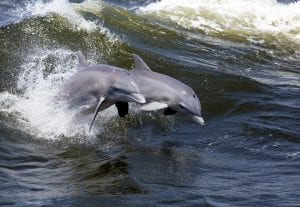Connect With Your SF Bay Gentle Giants
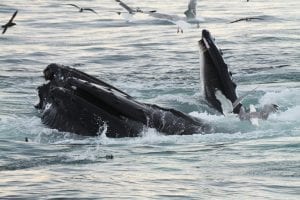
Humpback whale
Whales are charismatic creatures. They have a powerful effect on us and such an unparalleled presence in the sea that they truly connect us to our marine environment.
In May through summer of 2016 Humpback and Blue whales were seen feeding off the coast of San Francisco in unprecedented numbers. No one seems to know if it was due to warm waters, an abundance of food – Krill, Anchovies. etc. – or due to Climate Change.
Lucky for porpoise, dolphin and whale lovers around the San Francisco Bay, Harbor porpoises and Bottlenose dolphins now seem to be inhabiting the Bay and more Humpback Whales are visiting during unusual times of the year. According to scientists at the American Cetacean Society, SF Chapter, Bottlenose dolphins were rarely found in the Bay prior to the 1982-3 El Nino.
Due to advances in identification and tracking technologies, we can get to know these gentle giants from our computers, out on the water or even studying to become naturalists and sharing your whale knowledge with others.
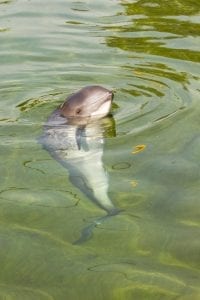
Curious Harbor porpoise
Golden Gate Cetacean Research (GGCR) is devoted to research on cetaceans to add to the body of knowledge about porpoises, dolphins and whales inhabiting the SF Bay waters, so that proper conservation efforts can be made. This team (cetacean researchers) possesses strong expertise in identifying and photographing these mammals. They can track Harbor porpoises and Bottlenose dolphins by matching their scars and pigmentation in their photo journals.
Their findings show:
- Porpoises are now in SF Bay year round
- Up to a hundred porpoises can be seen in the Bay on a single day
- Mothers seem to be raising their calves in the Bay; they think maybe using the sheltered waters as a nursery
- Bottlenose dolphins arrived in SF Bay in 2001 and there are now about 90 of these dolphins in the Bay, most of whom match photos from Monterey Bay, though one is from Ensenada, Mexico!
- Bottlenose dolphins are being tracked by photos of scars along their dorsal fin, emerging from their backs
- They can track Humpback whales by comparing the underside of their flukes
Two Bottlenose Dolphin
You can participate in GGCR’s research program in three ways:
- Report sightings of Harbor porpoises north of the Richmond-San Rafael Bridge or South of the San Francisco – Oakland Bay Bridge.
- Take photos of the dorsal fin of Bottlenose dolphins sighted north of Half Moon Bay and they will try to match the photos.
- Report any sightings of a Humpback whale in the SF Bay Area. Take photos of their flukes on their tail, if you can.
You can also have some fun with Happywhale, a website which has a lot of information about Humpbacks seen around the Bay Area. There you can become part of their community and upload your whale photos from your encounters and scientists will help you identify your whale through their unique markings on their flukes and dorsal fin and track it as it travels around the globe. According to their website, they “…use state-of-the-art image processing algorithms to match whale photos with scientific collections.” You can learn your whale’s story – its travel patterns and where it goes to have its calves. Check out sightings reported to Happywhale.
If you really love whales, you can become a SF Bay American Cetacean Society Chapter* Naturalist through the SF Bay ACS Chapter Naturalist Training Program. “Once trained, our naturalists will help other community members observe and interpret our local marine habitat,’ (website).
Once you become a Naturalist you can represent SF Bay ACS in tours, in classroom visits, at festival exhibits and events in the Bay Area.
Classes:
When: Thurs., March 2, is the first class! This will be a 6-week course 6-9pm pm. On these Thursdays: Mar. 2, 9, 16, 23, 30, Apr. 6
Where: Sports Basement @ Presidio, 610 Old Mason St. in San Francisco
*The San Francisco Bay Chapter of the American Cetacean Society (SF Bay ACS) protects whales, dolphins, porpoises and their habitats through public education, research grants, and conservation actions.
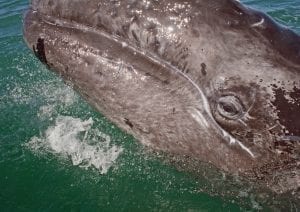
Gray whale calf born in Baja, Mexico
Whale Watching:
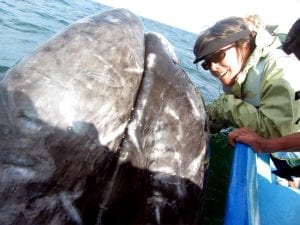
Up close & personal with Gray Whales in Baja
Watch Gray whales migrating Dec.-Apr. and during May – Nov., take trips to the Farallon Islands to see Blue, Humpback whales and others.
From BOWW website – what you will see: “It’s winter 2017 and the humpback whales are clearly here to stay! Most humpback whales have migrated south for the winter to Mexico and Central America to mate and give birth. Though many have remained in the bay to feed on the abundance of anchovies making this the third year in a row humpbacks have been observed all year in Monterey Bay! We’ve also seen gray whales, dolphins, and have had one sighting of killer whales so far.”
Visit the Marine Mammal Center in Marin Headlines to get close up and personal with these wonderful mammals. There are many ways to get involved in their volunteer programs.
- Jan. 2 – Feb. 17, 2017, Tours available:
- Mon. and Fri. , 1pm and 3pm
- Sat. and Sun., 11am, 1pm and 3pm
Special for President’s Day Week
- Feb. 18 – Feb. 26, 2017, Tours available::
- Daily at 11 a.m, 1 p.m and 3 pm
- Feb. 27 -Mar. 24, 2017, Tours available:
- Mon. and Fri., 1pm. and 3pm
- Sat. and Sun., 11am, 1 pm and 3pm



